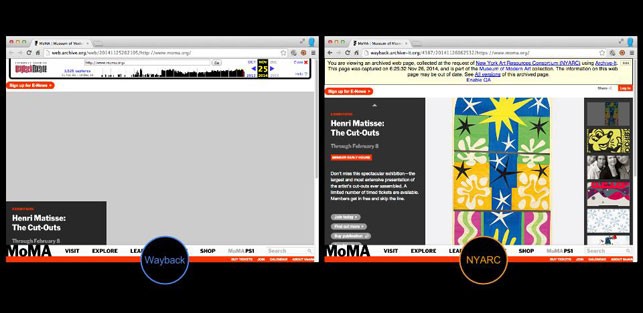Always having their heads in the past has meant that archivists and museum organizers are generalized as old curmudgeons who can’t see the future through the coat of dinosaur dust on their glasses. But the MoMA continues to earn the modernity label embedded in its name, as an emblem of what a museum can be when it embraces the ephemeral landscape of its subject. So when the screeching siren’s call of dial-up internet sounded, the Museum of Modern Art of course answered without skipping a beat, launching their website on May 25th 1995. As the MoMA blog post celebrating the anniversary points out, this means they had an online presence before even Google did. (So for those keeping score at home, thats museum curators: 1, techies: everything else.)
Since then, the MoMA has created over 200 exhibition websites. And after teaming up with the New York Art Resources Consortium (NYARC) last year, they’ve ensured a high quality preservation of all but fourteen of those exhibition sites (with the few stragglers still pending). You might be asking why the MoMA even bothered, since the Internet Archive already lets anyone auto-preserve everything under the internet’s sun. But, due to complexity or obscurity, many of their exhibition sites require the human touch of a web archivist for full preservation.
So, like a restoration artist lovingly and painstakingly examining each stroke of a painting, the web archivist must ensure each link, structural file, image, and video remains intact and accessible. Which can get overwhelming, to say the least—especially for those exhibitions that purposefully tested the limits of the internet’s interactive capabilities (i.e. answering the age old question of how many links can one cram into a single flash site?). You can see the visible difference between the two preservation methods juxtaposed below.

For future art historians of the world, both the MoMA and the NYARC are doing invaluable work, by ensuring that this moment in time—when technology and art have never been more in bed together—is recorded for centuries to come. A little known art known as “videogames” even managed to make it into MoMA’s archival history, through the museum’s game-changing announcement that it would house fourteen titles in its permanent collection. The more formal exhibition websites also tell their own story on the marriage of art and technology in the digital age, serving not only as a documentation of art, but also as an “online museum of the Internet,” showing just how far the web has come itself as a work of art and design.
